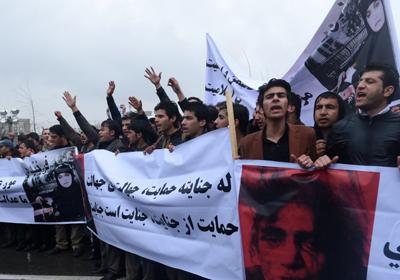Farkhunda Malikzada was brutally murdered by a mob in Kabul on Thursday March 19th in a crowded part of town, only miles away from the district police and the Presidential Palace.
The 27-year-old was accused of burning the Quran, after which she was beaten and tortured to death and put on fire by nearly a thousand angry men. The crime was fully documented with cellphones and was shared on social media within hours.
Reactions
Within hours of the attack, social media was overwhelmed with mixed responses. Some people expressed strong disagreements, shocked to see that this time the perpetrators weren't part of IS or the Taliban, but rather young men living, studying, and working in the city. Meanwhile, others, including few well-known—now notorious— public figures, expressed their sympathy with the mob for 'defending the country and religion's honor.'
The incident caused national outrage and condemnation only after it was confirmed that Farkhunda was wrongly accused and was indeed a conservative, religious woman herself. This has left room for implications that 'mob justice' would be tolerable had she been guilty of blasphemy or burning the Quran.
The Question of Responsibility
When a large group of people commit a collective crime, the question of responsibility becomes blurry and complicated. Does the responsibility lie with the main perpetrators only? If not, then whom else and to what extent? The Mullah who wrongfully accused Farkhunda? The people who physically took part in the murder? The people who watched, cheered, and took pictures? The police? What about the public figures who expressed sympathy— creating and altering public mindsets?
And what about the little children smiling as Farkhunda's dead body burned in fire? Who is responsible for exposing them to such violence? Who is responsible for the violence they will most likely commit when they grow up?
The police has arrested 19 of the main perpetrators thus far. However, considering the nature of the case, evidently there are many others who now roam freely among us. The police and the justice system are up for a challenge: to arrest and prosecute every single person who has been involved so that no such incident occurs in the future. How? We shall see.
The Gender Element
Would there be severe reactions had a man allegedly burned the Quran? Absolutely. Would he be treated the same way Farkhunda was? Absolutely not.
Misogyny was a big part of the way Farkhunda was killed. The men's immediate and intense attention to the man who accused Farkhunda, while ignoring her side of the story clearly show the power dynamics that played into the murder.
Additionally, the incident became an opportunity for the men to take out years of hatred, repressed anger and frustration by groping Farkhunda's wounded body, pushing her, and torturing her, with signs of pride and excitement visible on their faces.
The mob attack was a case of violence and brutality against humanity, but particularly, a case of violence against women. Hence, it has caused fear and outrage among women who are overwhelmed with fears and what-ifs, as they chant "we are all Farkhunda" and "we want security for women" slogans in the protests the past couple of days.
The Protest
The civil society arranged a protest in front of the Supreme Court in Kabul on Tuesday to condemn the horrific murder and demand that justice be served. Despite heavy rain, nearly 2,000 people showed up, making for a proud moment for Kabul and showing that last Thursday's barbarism doesn't represent the city.
That said, there were issues that created disappointment and rage among many female protesters. To begin with, some men had taken the front row (earlier pushing women to make their way up front) so they could pose in front of the media. Meanwhile, the media would stop the protesters in the front row every few minutes to direct them as to how they should pose for pictures. Moreover, an extremely disturbing selfie mania, the narcissistic tradition of our generation, found its way among the crowd. Pictures with the signs. Pictures with the crowd. Tweet. Tweet. Tweet. It all became about "me, myself, and I."
There was one young man in particular who would jump among the crowd (so that the cameras could capture how much he cared) while screaming Adaalat, Adaalat (Justice, Justice) as though it was a song, with a disturbing smile on his face.
The protest was a time for collective mourning, for collective justice-seeking. But unfortunately, in more than few occasions, it seemed like a calculated showcase with competition over the spotlight. Such self-centered attitudes can cause disinterest among the public, create a negative image of well-intentioned civil acts, as well as allow extremists and their sympathizers opportunities to use the situation to their benefit.
Where Do We Go From Here?
The government as well as non-governmental organizations should focus systematic, strategic attention to mental health, education reform, awareness-building at the grass-roots level, creation of job opportunities, focus on legal reform and implementation, and most importantly nation-wide campaigns to teach the youth respect and tolerance.
Additionally, it is important that Farkunda is not forgotten. Her story should not be lost in the nation's selective memory; it should be remembered as a national tragedy, as a taint on the national honor. Only then can we ensure that no such tragedy happens again.



Comment this post